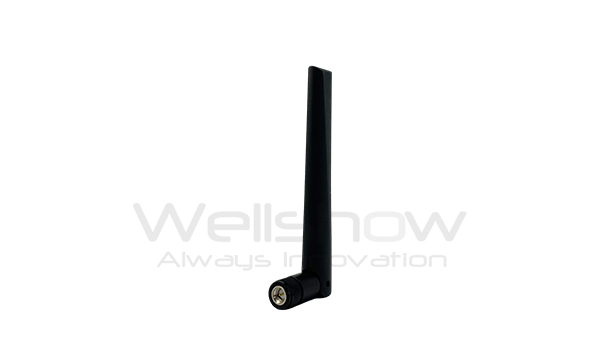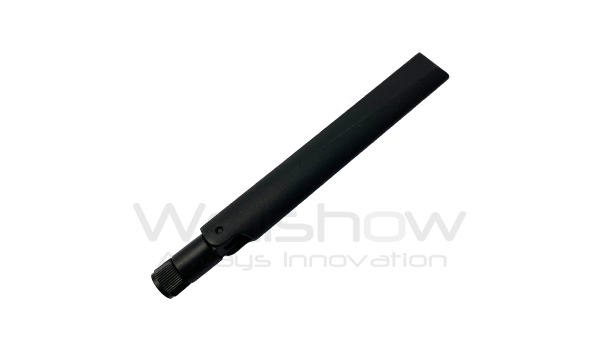- BNC Connector
- Fakra Connector
- FME Connector
- MCX Connector
- MMCX Connector
- N Connector
- QMA Connector
- QN Connector
- RP N Connector
- RP SMA Connector
WiFi 6e/WiFi 7 Antenna, 2400 – 2500, 5150 – 5875, 5925 – 7125MHz, swivel type with RP SMA(M)
Product Number:
AR048WSW0719N
Downloads
WiFi Antennas: Enhancing Wireless Connectivity
WiFi antennas are essential components for wireless networks, enabling devices to communicate seamlessly over short to long distances. Wellshow provides various Wi-Fi antennas for you.
Wi-Fi Technology Generational Timeline:
|
Wi-Fi Name |
IEEE standard |
Release Year |
Frequency (GHz) |
|---|---|---|---|
|
Wi-Fi 7 |
802.11be |
2024 |
2.400 – 2.483 GHz 5.150 – 5.850 GHz 5.925 – 7.125 GHz |
|
Wi-Fi 6E |
802.11ax |
2020 |
5.925 – 7.125 GHz |
|
Wi-Fi 6 |
802.11ax |
2019 |
2.400 – 2.483 GHz 5.150 – 5.850 GHz |
|
Wi-Fi 5 |
802.11ac |
2014 |
5.150 – 5.850 GHz |
|
Wi-Fi 4 |
802.11n |
2008 |
2.400 – 2.483 GHz 5.150 – 5.850 GHz |
|
Wi-Fi 3 |
802.11g |
2003 |
2.400 – 2.483 GHz |
|
Wi-Fi 2 |
802.11a |
1999 |
5.150 – 5.850 GHz |
|
Wi-Fi 1 |
802.11b |
1999 |
2.400 – 2.483 GHz |
|
Wi-Fi |
802.11 |
1997 |
2.400 – 2.483 GHz |
Bluetooth: Connecting Lives, Simplifying Everything
Most Bluetooth devices still operate in the 2.4 GHz frequency band. With the introduction of Bluetooth 5.0, it has added support 2.4 GHz and 5 GHz frequency bands. All Wellshow 2.4GHz antennas can work as bluetooth antenna.
Smart Homes and IoT: Bluetooth technology connects devices like smart lighting, home security systems, smart locks, sensors, and more, enabling intelligent control and monitoring.
Medical Applications: Bluetooth antennas are used in medical devices such as heart rate monitors, blood pressure monitors, and glucose testers, facilitating wireless transmission and monitoring of medical data.
In-Car Entertainment and Automotive Systems: Bluetooth connectivity is widely utilized in in-car entertainment and automotive systems, enabling features such as audio streaming, mobile phone connectivity, vehicle diagnostics, and more.
Development of Bluetooth Technology:
◾ Bluetooth 1.0 to 2.1
The initial Bluetooth versions (1.0 to 2.1) operated in the 2.4 GHz ISM (Industrial, Scientific, and Medical) frequency band. These versions were primarily used for simple data transfer and audio streaming, such as pairing headphones and mobile phones.
◾ Bluetooth 3.0 and 4.0
With technological progress, Bluetooth 3.0 introduced high-speed data transfer modes while still utilizing the 2.4 GHz frequency band. Bluetooth 4.0 introduced Low Energy (Bluetooth Low Energy or BLE) mode, expanding its applications to include wearable devices, smart homes, and Internet of Things (IoT) applications.
◾ Bluetooth 4.2 and 5.0
These versions improved BLE performance and enhanced privacy and security. Additionally, Bluetooth 5.0 supports both the 2.4 GHz and 5 GHz frequency bands, offering extended transmission ranges and higher data transfer rates.
◾ Bluetooth 5.1 and 5.2
These versions introduced location-based technology known as Direction Finding BLE, enabling precise object positioning. This feature is particularly useful for indoor positioning and locating lost items.
| Product Type Features | Antenna Termination: RP SMA Male |
| Configuration Features | Mounting Location: External Antenna Type: Terminal/Duck/Whip Band Type: Triple Band Port Configuration : Single Port |
| Electrical Features | Impedance (Ω): 50 VSWR (Max): 3.0 Antenna Operation: Passive |
| Signal Characteristics | Frequency Band (MHz): 2400 – 2500, 5150 – 5875, 5925 – 7125 Peak Gain (dBi): 5.0 Average Gain (dB): - |
| Mechanical Attachment | Mounting Type: Connector Polarization: Linear Directionality: Omni-directional Antenna Environment: Indoor |
| Industry Standard | Wireless Application: Bluetooth, ISM, Zigbee, Wi-Fi |
| Dimensions |
Product Length: 139.9 mm / 115 mm (Bent) Product Width: 18.9 mm |
Related Products
868MHz, 915MHz ISM/Zigbee/RoLA Antenna, swivel type with SMA plug, L108
AR003WSG0801N (868MHz, 915MHz)
868MHz, 915MHz, 2.4GHz Glass Adhesive type to RG174(BK) to SMA(M), L=3M
AG00255G26005 (868MHz, 915MHz)
868MHz, 915MHz, Glass Adhesive type to RG174(BK) to SMA(M), L=3M
AG001WSG08005 (868MHz, 915MHz)





